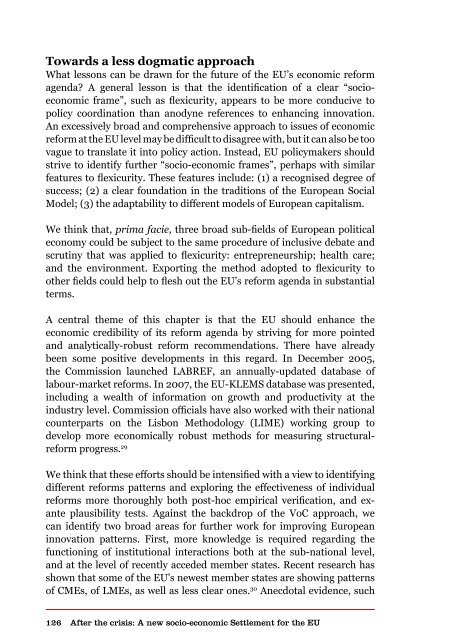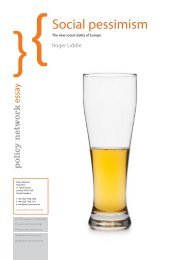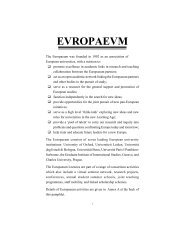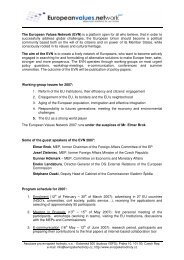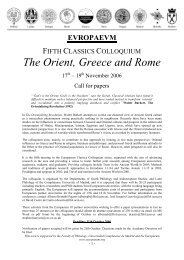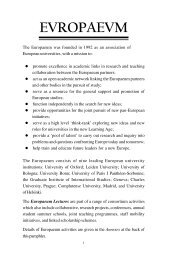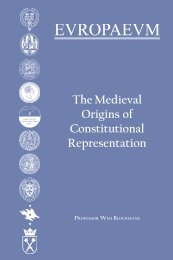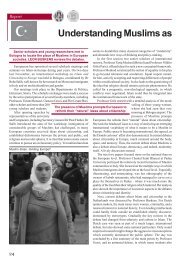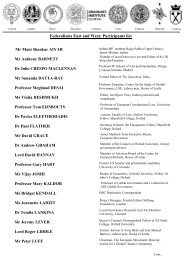Authors Iain Begg | Gabriel Glöckler | Anke Hassel ... - The Europaeum
Authors Iain Begg | Gabriel Glöckler | Anke Hassel ... - The Europaeum
Authors Iain Begg | Gabriel Glöckler | Anke Hassel ... - The Europaeum
You also want an ePaper? Increase the reach of your titles
YUMPU automatically turns print PDFs into web optimized ePapers that Google loves.
Towards a less dogmatic approach<br />
What lessons can be drawn for the future of the EU’s economic reform<br />
agenda? A general lesson is that the identification of a clear “socioeconomic<br />
frame”, such as flexicurity, appears to be more conducive to<br />
policy coordination than anodyne references to enhancing innovation.<br />
An excessively broad and comprehensive approach to issues of economic<br />
reform at the EU level may be difficult to disagree with, but it can also be too<br />
vague to translate it into policy action. Instead, EU policymakers should<br />
strive to identify further “socio-economic frames”, perhaps with similar<br />
features to flexicurity. <strong>The</strong>se features include: (1) a recognised degree of<br />
success; (2) a clear foundation in the traditions of the European Social<br />
Model; (3) the adaptability to different models of European capitalism.<br />
We think that, prima facie, three broad sub-fields of European political<br />
economy could be subject to the same procedure of inclusive debate and<br />
scrutiny that was applied to flexicurity: entrepreneurship; health care;<br />
and the environment. Exporting the method adopted to flexicurity to<br />
other fields could help to flesh out the EU’s reform agenda in substantial<br />
terms.<br />
A central theme of this chapter is that the EU should enhance the<br />
economic credibility of its reform agenda by striving for more pointed<br />
and analytically-robust reform recommendations. <strong>The</strong>re have already<br />
been some positive developments in this regard. In December 2005,<br />
the Commission launched LABREF, an annually-updated database of<br />
labour-market reforms. In 2007, the EU-KLEMS database was presented,<br />
including a wealth of information on growth and productivity at the<br />
industry level. Commission officials have also worked with their national<br />
counterparts on the Lisbon Methodology (LIME) working group to<br />
develop more economically robust methods for measuring structuralreform<br />
progress. 29<br />
We think that these efforts should be intensified with a view to identifying<br />
different reforms patterns and exploring the effectiveness of individual<br />
reforms more thoroughly both post-hoc empirical verification, and exante<br />
plausibility tests. Against the backdrop of the VoC approach, we<br />
can identify two broad areas for further work for improving European<br />
innovation patterns. First, more knowledge is required regarding the<br />
functioning of institutional interactions both at the sub-national level,<br />
and at the level of recently acceded member states. Recent research has<br />
shown that some of the EU’s newest member states are showing patterns<br />
of CMEs, of LMEs, as well as less clear ones. 30 Anecdotal evidence, such<br />
126<br />
After the crisis: A new socio-economic Settlement for the EU


